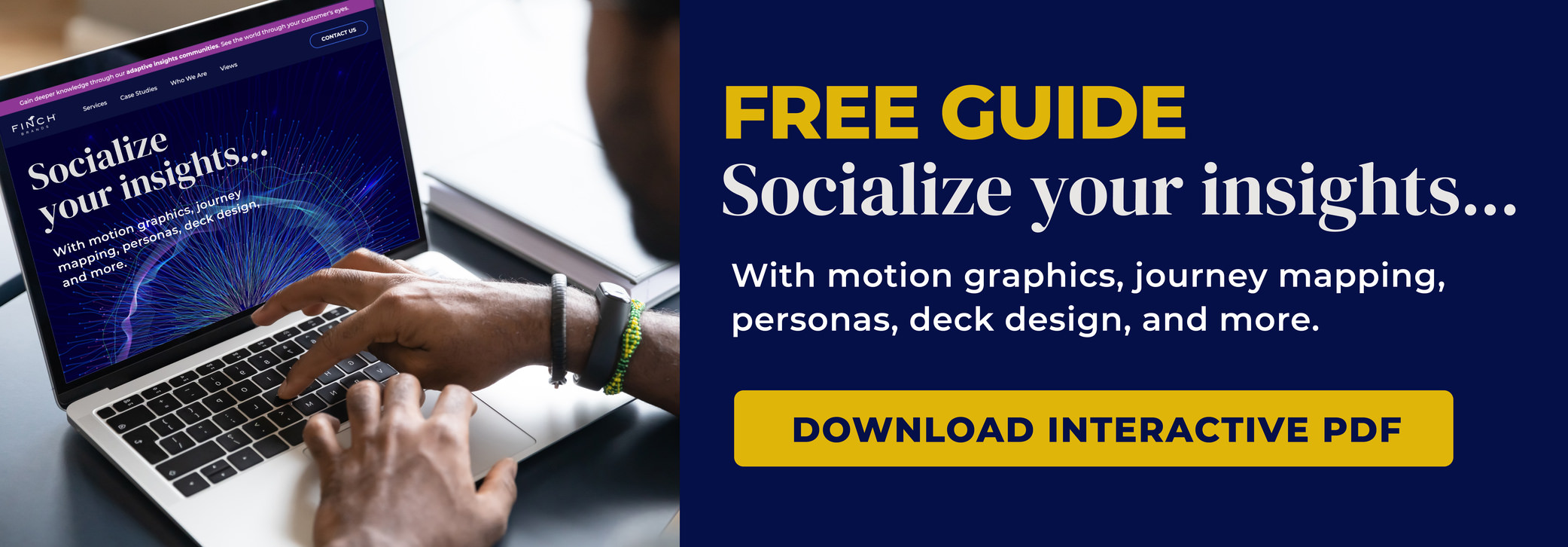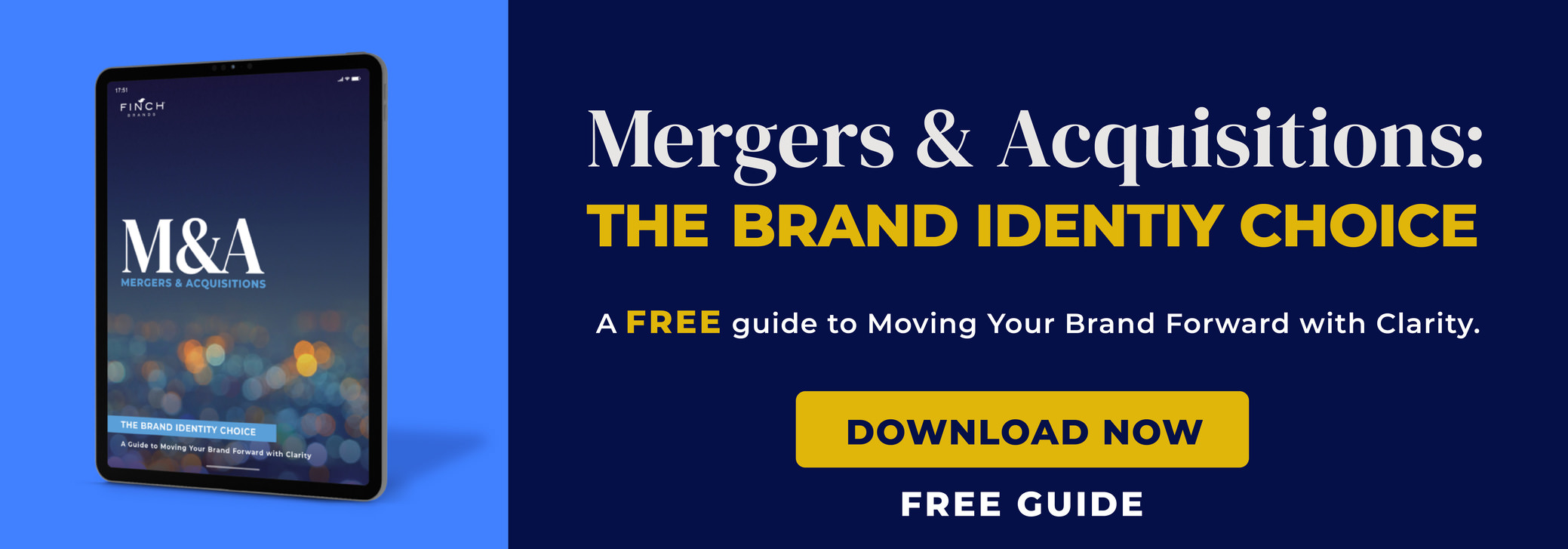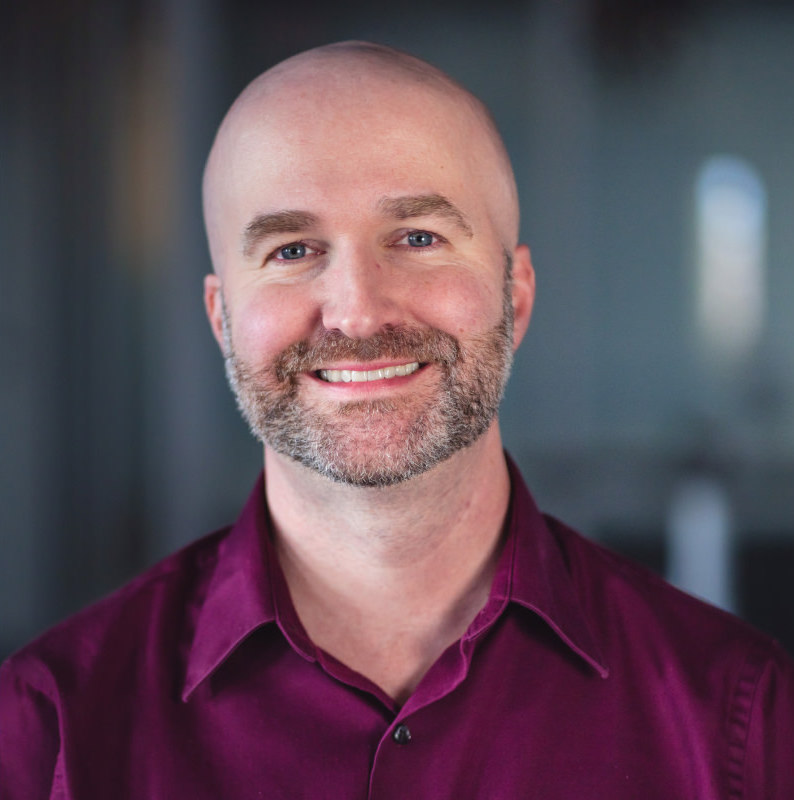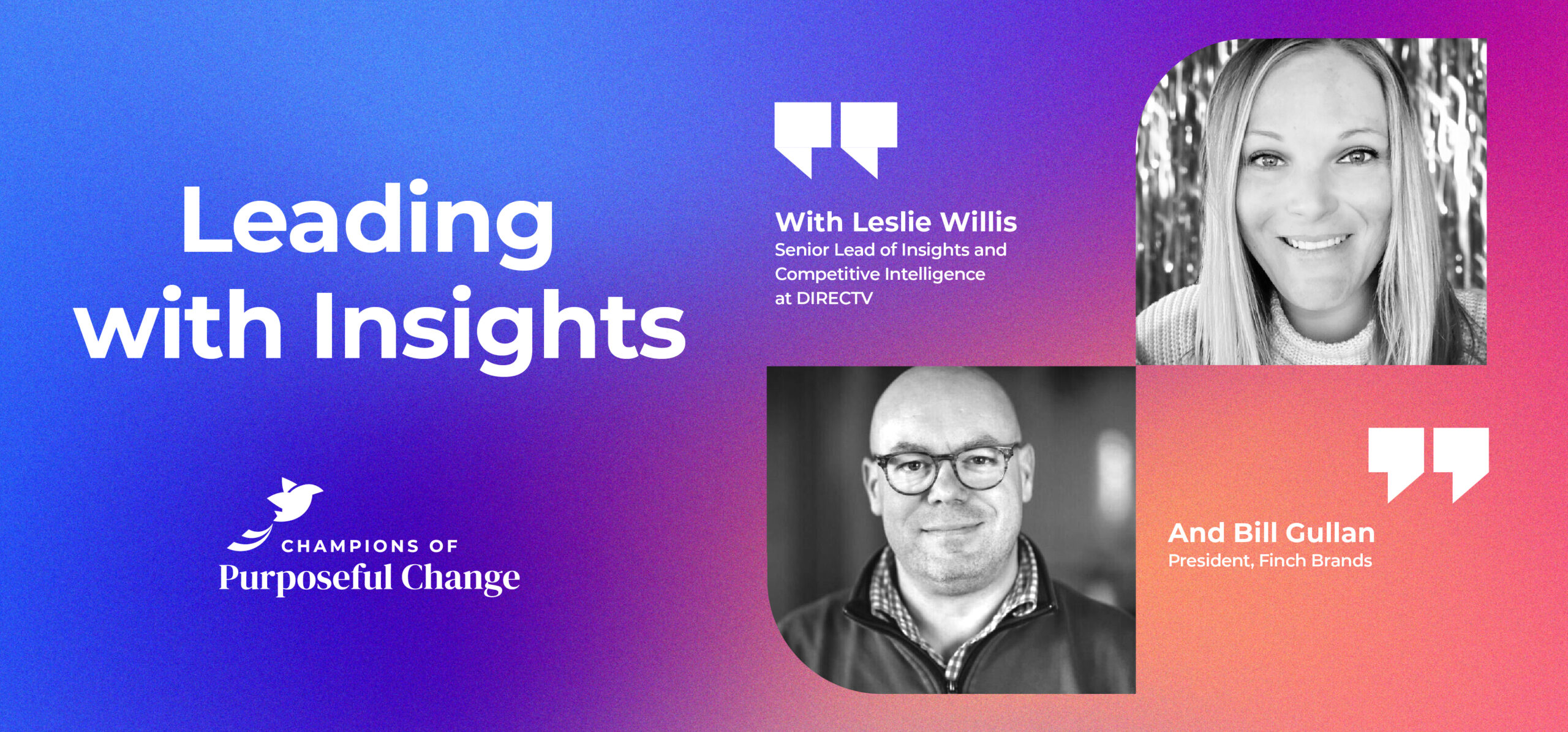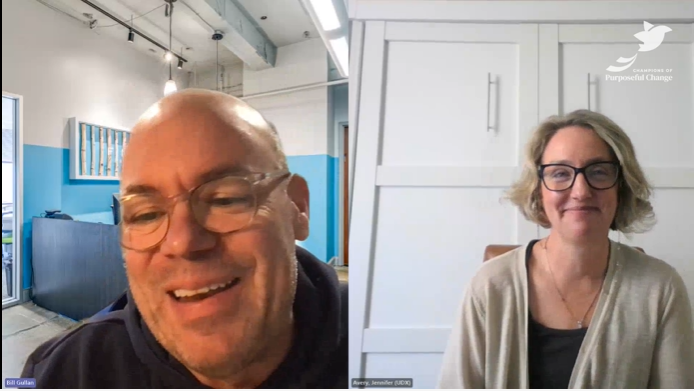Socializing Insights and Data Visualization

Make Data More Accessible with Visualization
In this episode of Real-World Branding, our President and host, Bill Gullan talks Socializing Insights with Victoria Ng, Director of Consumer Insights at Sodexo.
Finch Brands runs a University Student Lifestyle brand tracker for Sodexo and they’ve been one of our more adventurous and forward-thinking clients, asking us to help them socialize the insights gathered from their brand tracker and create a motion graphics video using that data. We loved working on this project and so we thought you too might love to hear from the person behind the scenes at Sodexo, Victoria Ng, Director of Consumer Insights.
By socializing the data and making it appealing to more than just researchers, it extends the life and purpose of the data.
Are you making your data sets more digestible by creating visual stories to accompany the data? Should you be? We think so.
Thank you for listening to our podcast (below) with Bill Gullan and Victoria Ng as they talk Insights Socialization.
And while you’re listening, don’t forget to check out our Socializing Insights blog post and watch how we translated Sodexo’s data into a video.
You can now find videos of our podcast recordings on YouTube.
Follow us:
Instagram: @finchbrands
Twitter: @finchbrands
Facebook: Finch Brands
LinkedIn: Finch Brands
Podcast: Download Subscribe: iTunes | RSS
Bill Gullan: Greetings, one and all. This is Real-World Branding. I’m Bill Gullan, President of Finch Brands, a premier boutique brand consultancy, and thank you for joining us today. I know our timing has been a little bit intermittent, as I always say, we’re trying to get back to monthly at least.
And we are again, here in ’23, and we have a terrific guest to kick off the year. Victoria Ng, who’s a Director of Insights at, as she will tell you, a really large and meaningful company, that some folks have probably interacted with in many cases, maybe without knowing it. Sodexo is a food service leader in higher ed and corporate and healthcare and government, and in all these other segments. They provide food and beverage services, so sometimes under different brands, under different brand names that you may be familiar with. So if you go to a hospital and have a meal or a cafeteria on a campus, et cetera, that’s likely them.
Victoria is going to walk through her career, which is fascinating, as well as spend some time discussing a particular university lifestyle tracker that they run every two years, and that we at Finch were honored to be part of this latest go around. And I think the thrust of the comments, as the conversation goes on, is really about not only how to collect that data, but how to make that data achieve its full potential internally and externally through visualization and socialization, which she was a very strong leader for us in that regard. So enjoy hearing from Victoria Ng.
Bill Gullan: We are so pleased and proud to have Victoria Ng with us today. Victoria is the Director of Consumer Insights at Sodexo, which probably most of you know what they do. I’ll ask Victoria to start, and thank you for being with us.
Victoria Ng: Of course, Bill. Thanks for having me on today.
Bill Gullan: Now it really is our pleasure. And let’s start where we typically do, with a little bit of a walkthrough your journey to the present role. How insights was sort of awakened in you as a passion, and some of the stops you’ve made along the way. If you could take us through that, we’d love to hear it.
Victoria Ng: Yeah, sure. I’ll try to keep this short and sweet. But I majored in psychology as an undergrad at the University of Virginia, and so I’ve always, always been interested in consumer behavior in general. And I was trying to figure out, okay, well, how do you take that passion or interests and make it marketable, like you actually create a career out of it.
And so branding and marketing was another interest of mine. And I was fortunate enough to find my first opportunity in consumer research, actually started in Shanghai, China. So over in Asia I started at a small innovation agency that was working to use consumer insights to help multinational companies break into the Asian markets. And so a lot of that was super cool work. I mean, China was emerging at the time, it was early 2011, I think, around the time was when I was there. So kind of a newer market to American companies especially. But they just wanted to figure out, “How do I bring my brand and how can I bring my products into the Asian markets and make it relevant for consumers there?” So it was a lot of qualitative work, a lot of co-creation workshops with clients and consumers, and just super fast paced and really, really interesting.
Loved that kind of research and working with the smaller team. But because that was my first role in insights, I also wanted to gain experience working at a larger research agency, just because they have other tools and methodologies that I might not have been exposed to at the time. And so I started working at Millward Brown a few years later, still in the Shanghai office. And so that was my first exposure to how to marry qual and quant together, because that’s obviously what they do well and one of their areas of expertise. And so that opportunity was also really fantastic, just because it gave me a broader exposure to different industries, working with different types of clients around the world, and super fun team to be on there as well.
And then after that, I realized at some point that I had spent a little bit too long outside of the US and I wanted to build a longer term career back here in the States, that I felt like I needed to start building my career in the US as well. And an itch I guess I had at the time was also just gaining more experience in developing brand strategy. So really using insights to build strategies for these bigger brands. And so I found an opportunity at a branding agency in New York City and worked there for a couple of years, really just trying to hone those skills and scratch that itch, so to say. But I did realize that I really missed the consumer research aspect of it all.
And so came back to research a few years later, started working at an online community focused agency, and that was also my first exposure to the tool at the time. And it was still relatively new in the market, I would say, and it wasn’t something I had worked with before. Now they’re everywhere, everyone runs an online community platform, and I think they’re fantastic for a variety of reasons. And it was that, again, exposure and experience with that tool was fantastic. And that team got acquired by LRW, which I believe you’re familiar with as well, but a larger research firm based out in LA. And so that, again, just led to additional opportunities. Building out a new team based on the new acquisition. Again, learning their tricks and tools of the trade, because they specialize in a lot of entertainment clients out in LA and all of that. Again, just great exposure to a variety of industries and clients.
And at that point, all of my research experience had been on the agency side. And there’s a lot of benefits to that because you get to work on different brands and different types of projects, and it’s super interesting and fast-paced all the time, but there was always that part of me where … I think people that work on either client or agency side maybe always wonder what it’s like on the other side-
Bill Gullan: Sure.
Victoria Ng: … those things. So I found a client side role at UCLA on their marketing team. And so that was a really cool experience to be able to use the insights to help academic departments develop programs and courses that matched what employers were looking for, and the skills that students needed to develop to meet the needs of the employers.
And so that, I think, was a really great way for me to just get exposed to seeing, okay, how do you take insights and carry it all the way through to the end so you have some just tangible outcome with it. You’ve developed a strategy, you’re actually creating the, for example, academic programs that were derived from the consumer research that you’ve done. Because I think that’s something that was missing for me on the agency side was, you don’t always get to see the final outcome or output of the research that you’ve done. And so just being able to have that tangible outcome for me was a big motivation for going to the client side.
And now at Sodexo I am doing the same thing with consumer insights for their universities and school segments, which is really helping our teams create a deep, empathetic understanding of who our students or who our consumers are today. What are their needs around food and food service specifically to help us figure out, okay, what products and services do we need to develop or bring in to help deliver on those needs.
Bill Gullan: Right. What a journey you’ve had. Couple things, I was going to ask about supplier side versus client side and you answered it, and it certainly rings true with everything we’ve experienced and folks here.
Within the UCLA, at least according to your LinkedIn, there were some work that you did on certifications and other perhaps emerging opportunities within the higher ed setting. Any reflections on what that was like? It sounds like you worked on some more traditional coursework as it relates to employer connections and other things. But also in that emerging space, was that something that you did touch, and I’ve just been fascinated by that side of the role.
Victoria Ng: Yeah, yeah, definitely. I did a lot of work on their certificate programs, which are part of the Continuing Education branch of UCLA. And what was interesting is, traditionally I say for higher education, it was like you created it and people would come. Whatever you put out there, you look to the academics as experts, and they still are in their relative fields. So you thought, “Okay, if this person’s studying this or if they’re putting out a course on X, Y, and Z, that’s probably what should be important to the world and what I should be studying.”
But we were finding that there was a slight gap in between what academically we felt was important, but in the marketplace we’re seeing other skills or other types of needs from employers, saying, “Oh, with automation or with technology growing, here are the types of topics, or here are the types of specific skills that we want our employees to have or people that we’re hiring. This is what we’re looking for.”
And so being able to use research to really help bridge that gap, to say, “Here’s where the job market growth is happening. Here are the types of skills that are going to be essential to capitalize on that growth as an employee looking for work. And therefore, these are the types of academic topics or programs that we need to start developing to ensure that continuing education learners …” A lot of people that took the certificate programs were maybe people like you and I. You’re already in a career, but maybe you want to pivot to something else. Or maybe, “Hey, I’m looking to get promoted at my job. What are the types of skills that I need to help me get there?”
And so that’s where our programs will come in and say, “Take our course, it’s super short and sweet. And we’ll be able to help provide you with that experience and those skills to be able to help you either pivot in your careers,” or get that promotion or get that raise or whatever they were looking for.
Bill Gullan: Yeah, cool. Fascinating. I mean, the higher ed marketplace has some demographic headwinds and other challenges.
Victoria Ng: Yes.
Bill Gullan: And the ability to pivot in that direction of being valuable, with the rigor of UCLA and other institutions that have done this, while that informateur matters, the learning matters, and it’s a fascinating category.
[00:12:30] So Sodexo, I’m sure many of us know, but Sodexo is a leader in food and beverage programs for universities, which we’ll talk about in a minute, but certainly with strength in corporate office and healthcare and in other environments. Could you give us the lay of the land of how Sodexo’s organized, and you talked a little bit about your role, but give us the scoop on Sodexo?
Victoria Ng: Sure. It’s always funny because I think Sodexo is … I always joke that it’s probably the biggest brand name that most people know or have experienced but have never heard of.
Bill Gullan: Yeah. Right, right.
Victoria Ng: It’s a French-owned company. It’s a global company. And the business is organized by what we call segments. And so those are typically, if you think of different verticals within the organization, where we do deliver food services and facilities management to our clients. Exactly like you mentioned, we run food service and facilities management for corporate services, for government services and agencies, universities, obviously K-12 schools, healthcare, senior living facilities, and these live entertainment venues and airport lounges and things like that.
Again, it touches a lot of different facets of everyone’s daily lives. And so that’s why I say, you probably encountered us at some point and have eaten our food or experienced our service when you’re dining in an airport lounge, for example. But you just haven’t heard of the name behind it all.
Bill Gullan: Totally. And so you were attached, and obviously given your experience, you’re very well supportive of the higher ed vertical market. And when we met, you were pursuing the latest wave of what sounds like an ongoing tracker. Without telling us anything that might be private or proprietary, could you talk about the role of tracking and what the tracker is intended to do internally and externally, and how you conceive of it?
Victoria Ng: Yeah, definitely. Our Student Lifestyle Survey, which is the tracker that we had brought Finch in to help us with, it actually started about back in 2004, started in the UK business specifically. And they just wanted to understand, what are university students today looking for and what are their expectations [00:15:00] when it comes to a university experience. What are they hopeful for, what are they worried about, and things like that.
And eventually it expanded to a global tracker, because we wanted to understand what are some similarities and differences that we’re seeing across all of our university businesses around the world. I believe at the most, at one time we had about six countries, including the US, included in that tracker, which was absolutely fascinating to see.
Obviously, a couple years ago with the pandemic, that threw a wrench into things. And with different countries recovering at different rates and businesses just trying to figure out how to get back on track, we pivoted last year, when we ran the tracker, to just focus on the US only. Because we, again, understood the value that the insights brought from the tracker to really help us understand and tell that story about how we, as Sodexo, can help our clients, and ultimately students at those specific universities, increase campus engagement, increase their education around wellness and nutrition and health and mental health and things like that.
We were so excited to be able to do that study, again, more focused on the US, with Finch last year. And even more excited to include, for the first time ever, a small cohort of high school students.
Bill Gullan: Oh, cool.
Victoria Ng: Which obviously they are relevant for our K-12 schools business, but historically in the tracker, we had never included high school students before, but we felt like it was important to because they are our future university customers.
Bill Gullan: Sure.
Victoria Ng: And so what better way to understand what types of experiences we need to build today, than to understand what that future generation is going to be looking for in terms of a university experience.
Bill Gullan: Right. And so, correct me if I’m wrong and [00:17:00] expand on what I share, but I know the tracker certainly has, and the Lifestyle survey, has internal value, in terms of product development and planning and ensuring that Sodexo’s offerings create high engagement and meet the needs of students, faculty, and staff.
At the same time, this does have some sales and marketing value. I’ve heard and believe obviously Sodexo seeks to position as thought leaders seeks to be or earn the trust and opportunity, with various institutions. Could you talk about the internal and the external role of something like this?
Victoria Ng: Yeah, absolutely. For the external piece, I’ll start with … And it’s exactly like you mentioned. We wanted to be able to continue to position ourselves as thought leaders in campus engagement with our clients, and potential future clients too, just within the industry as a whole.
And one of the ways that we try to do that is through these types of research and studies that we can use in speaking engagements or discussions with, again, existing or new clients to say, “Tell me about your campus challenges today.” And a lot of that that we hear does involve campus engagement. So, “How do I get my students involved with campus activities a little bit more? How do I make them feel like they belong at the university?” Because the ultimate goal of all of our clients and all these universities is to make sure that a freshman that enters graduates as a senior three, four, however many years later.
And so that retention aspect is super important. And just making sure that’s sustainable across the years and over time is really key and a really priority for a lot of our clients. And so we like to think of ourselves as an enabler in helping students engage with their campus community through food specifically, but also through spaces, through some of the wellness programs that we offer, and among other factors like that.
And so last year, specifically, we wanted to think about, “Okay, how can we help increase our position as thought leaders, and how can we even increase our speaking engagements?” Or what we can do with these insights throughout the year. And we really had to take a step back and think about, how have we told the story in the past, what has worked well, what hasn’t, and how do we want to continue telling that story in the future.
And this year specifically, especially with your team, since you have a fantastic creative team as well, we made the decision to invest in bringing that data to life in ways that we hadn’t done before. So with your creative team we had created those motion graphics of the college student personas and the high school personas, and we had one-pagers of each of those personalities or personas as well.
And those, again, have come a long way. And again, it’s something that we hadn’t done before in terms of really telling that story in a more visual way. So when we go to trade shows now we have the video playing in the background, so people walk by and say, “Hey, that seems really interesting. Tell me more about the study that you did,” or, “Tell me more about what you’re learning about the university student experience.” And maybe they’ll be able to learn something that they hadn’t heard before. So it just really helps lengthen the data, and it helps us squeeze all of the juice that we can out of this research and continue to build that equity with our clients in that way.
Bill Gullan: No, totally. And I want to get to that in a second, but I mean, without giving away the whole data set, I mean, food service, you hit on, it is fundamental. It’s not ancillary, it’s a catalyst for social life. It’s a catalyst for nutrition and sustenance. These spaces are central gathering places that promote engagement and enhance mental [00:21:00] health. And Sodexo really does, and we’ve been so impressed by how holistically the organization views its role in, you talk about engagement and retention. It really comes through that Sodexo is not thinking only about what ought to be available on the menu, but its role in campus life and student life.
You mentioned socialization, and that’s in many ways, having come through this with you and sharing the philosophy of its importance, was one of the reasons why we wanted to go deeper today. You’ve been a supplier at small, medium, and large organizations. You certainly now put in your time on the client side as well. You mentioned internal audiences, who maybe non researchers or many of them are, you mentioned external audiences, clients and prospects who are trying to make sense of this. How does data visualization or socialization, things like motion graphics, things like one-pagers, what is the role and power and potential, I guess, of that as a method to activate really the full potential of that data set?
Victoria Ng: Yeah, no, that’s a really good question. And I’m sure you’ve come across this in a lot of the work that you do as well. But for me, from my experience, it’s just a way of bringing the data to life in a way that creates empathy and engages [00:22:30] people in wanting to learn more about what you know, about the research that you’ve done.
And so I think anyone can look at a spreadsheet or look at different pieces of data and create their own points of view from it, but the storytelling aspect is something that everyone craves today. And I think that’s what’s going to get the point across in a stronger way that makes it stick as well. Because I can throw out tons of data points on the student lifestyle, student living, and mental health issues and all of that, but to see it play out in a video or even just as a one-pager or as a graphic I think just stays with people a little bit longer.
And again, I just think being able to tell a story with the data is probably one of the most important things that senior leaders, at least in our clients specifically, look for as well. Because it’s all about translating, “Okay, what does it mean for me at the end of the day?” And then if you can tell me a great story coming out of it, then, “Oh, okay, great. Now I see the impact. Now I see why it’s important for me to think this way because of the data that I’ve seen presented.”
Bill Gullan: Right. And that process of turning data into genuine insight and then turning that insight into digestible, meaningful, vivid calls to action really, for clients as well as internally, makes a ton of difference.
You mentioned some of the tactics that Sodexo has pursued on this one, motion graphics that bring to life these stories and these data points in ways that are easy to access and understand, and also at least intended to be very affecting as it relates to things like mental health and student life, that has broad extensibility, it sounds like, from sales presentations, to looping in trade show booths-
Victoria Ng: Yes. Yeah.
Bill Gullan: … to being vivid one-pagers, personas. I know that you are a really strong advocate of a variety of tactics, multimedia tactics here, to make this tracker or this lifestyle survey have meaningful and ongoing life within internal and external conversations.
Victoria Ng: Yeah, exactly. I think one of the interesting things about this tracker is that the data lives on, and we do it every two years. And so the data needs to live on, for the year that we conducted it, but also within the next year. I sit down with our audio engagement team and Stacy’s team, who you met as well, and really go through, okay, what are our upcoming engagement activities for the year? What are the trade shows or conferences that we’re speaking at? What are the different types of client engagements that we’re going to be presenting at?
[00:25:30] And then we then say, “Okay,” based on all of the different assets that we have today, which is great that we have a variety and not just a detailed PDF report or PowerPoint presentation or whatnot, to be able to sit down and say, “Okay, great.” Knowing how much time we have at this conference or what we’re presenting at this trade show, and matching it along with all the other initiatives that we have going on and saying, “Okay, now let’s put together this fantastic calendar of all the different types of activities that we can get out of this one piece of research.”
And just making sure that for each of those, throughout the year, that we always have something new to present and new to be talking about. Because we’re not just presenting the same data sets over and over again, but we like to, I will say gatekeep for a lack of a better word, certain things. We use the high school data, for example, as a nice gatekeeper for, “Okay, now you’ve heard us talk about the university students a lot, but now come back and hear us talk about how it affects high school students and what they’re expecting out of the university experience.” So keeping our clients engaged throughout the year with these little bits and pieces as well has been really just such a great benefit for us out of this research.
Bill Gullan: Yeah. Well, it was an honor for us to play even a meager part in it, and we so enjoyed learning. I mean-
Victoria Ng: Definitely more than meager.
Bill Gullan: The depth and texture of the university experience as it relates to food service, but more generally, is so rich. And I mean, to your point, every two years, when we’re working with general consumer products that are not related to a particular time and place like a college matriculation path, I mean, you think almost in terms of generations. I mean, two years is almost that, when it comes to-
Victoria Ng: Yeah, that’s true.
Bill Gullan: Especially with how much change that these folks have lived through. I mean, if you think about a four year, hopefully, four year [00:27:30] college experience, I mean, with COVID obviously, with economic challenges, with all of the forces that move so quickly to change and shape our lives. The great thing about a tracker and an ongoing survey is to be able to learn new things, but also to compare how attitudes and mindsets and behaviors are shifting.
It’ll be interesting to see next time around, if we’re ever … I mean, whenever, maybe post COVID, but it’s a little less acute maybe than it was.
Victoria Ng: Yeah.
Bill Gullan: Campus life’s a little freer maybe than it [00:28:00] was when this was mounted. We’ll see how big a difference it is. It’s fascinating.
Victoria Ng: Yeah. Yeah, exactly. I mean, that was one of the key questions that everybody was asking out of COVID. The changes that were created, or what were the impacts and effects of it, and how long-term or short-term are they.
Yeah, exactly like you were saying, we’re actually very excited for the next wave to start next year. Just to see if any of the changes that we saw over the past two to four years are here to stay, or if they might be reverting [00:28:30] back to normal, to pre COVID times. So it’ll be really interesting to see.
Bill Gullan: Yeah. And given Sodexo’s role and your role as a listener and a leader when it comes to client engagements and how food service is shaped in higher ed, I mean, it’s certainly in the company’s interest and has been its track record of being ahead of these shifts. I mean, things don’t change overnight. You don’t rip up a cafeteria or add a new … This takes a little bit of time, I would think, within the development cycle. And so yeah, that-
Victoria Ng: It does. Yeah, it does. And I think all of the talk around Gen Z and now with the upcoming Gen Alpha, I think everyone’s just on their toes just waiting to see, okay, how does what we know about this generation today, how is that going to impact what we need to deliver tomorrow? And because it’s such a fascinating generation. I’m a millennial so I can say they’re a little bit younger, there’s a lot of behaviors that I still don’t fully understand.
Bill Gullan: So entitled. [joking]
Victoria Ng: Yeah. There’s just a lot there, and it feels like it’s constantly changing. We’re having to keep up with all of the different changing trends and behaviors of this super interesting generation. And so I think it’s imperative for us to keep a pulse on our consumers because of this as well.
And so, yeah, I’m excited to, again, pick this up again next year and just see the trends and see what similarities or differences we had from just 2022, a short two years ago.
Bill Gullan: Totally. Well, I’m a proud Gen X’er, and I guess I don’t really change that much.
Victoria Ng: I know. I was going to say, at this point in my life
Bill Gullan: Yeah, you don’t need to-
Victoria Ng: … I’m not changing.
Bill Gullan: You don’t need to track me every seven or eight years.
Victoria Ng: Exactly.
Bill Gullan: Well, Victoria, thank you so much for your kind words and your partnership, and certainly for your time and insight today. It was a pleasure.
Victoria Ng: Of course. Thanks again for having me, Bill. And it’s a pleasure working with you and the team.
Bill Gullan: Thank you.
Thank you so much to Victoria for her time and her insight. Not only has she had a fascinating academic and career journey, she really shares, I think, with us a bunch of key philosophies around the power of insights, how they can be best socialized internally and externally. Internally, so that the company can learn from data points, and even non researchers can grasp the key things and take action against them. And then externally, within sales and marketing efforts, helping burnish Sodexo’s leadership position in terms of bringing meaningful data not only to the work that they do, but to the awareness of their clients and contacts.
As always, three ways to support us here at Real-World Branding, now that we’re back on it. One is to click Subscribe. Make sure you never miss an episode. Especially with our intermittent timing, clicking Subscribe within the podcast app of your choice, ensures that you do not miss an episode. When we post it, it’ll be there. Rate and review within podcast apps or stores of your choice. Rating gives us feedback, hopefully positive, but feedback that we seek to bring into future iterations of this to make sure it delivers value. The review also, pardon me, helps us learn. And if you like it, we’re told that the level of rating and reviewing does help us get found by people who would also enjoy this.
And then the third way is to keep the dialogue going on Twitter @billgullan, @FinchBrands. I haven’t been doing as much, I post random sports things. I’m not a prolific tweeter these days, but I do very much love to hear folks’ reactions to our topics, our guests, ideas for future topics and guests. So @FinchBrands, @billgullan, or any other way, email, however you’d like. We greatly appreciate the time that you’ve spent with us when we have one of these, and we want to make sure that each minute that you spend is valuable and enjoyable. So let us know how to do that.
It’s about to be playoff weekend in the Cradle Liberty. By the time you hear this we’ll know perhaps how the Eagles did this weekend, but hopes are high and spring training’s right around the corner. So we’ll sign off from the Cradle of Liberty.
